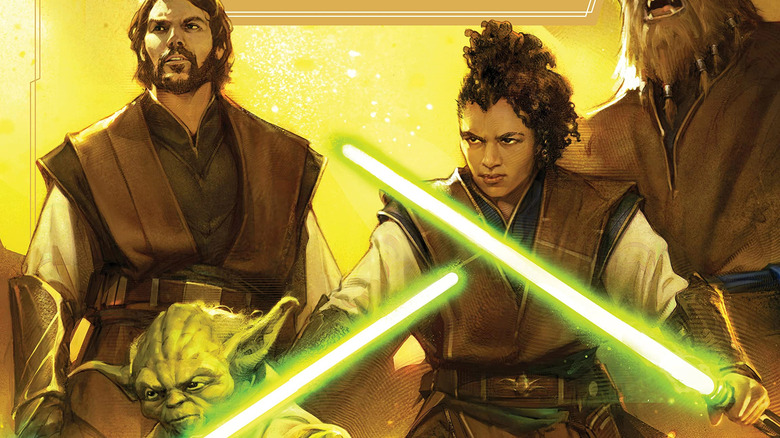
Kristin Baver is a very public face at Lucasfilm these days. Beginning as a writer for StarWars.com, she's worked her way up to the face of the "Star Wars" news show and has written several books about the franchise. Her first was the in-universe biography of the Skywalker family, "Star Wars: Skywalker — A Family at War." Her most recent foray into the world of "Star Wars" was overseeing the writing of "Star Wars: The Art of the High Republic," a tome that chronicles the unusual work of art output for a "Star Wars" publishing project, rather than a movie.
We spoke with Kristin at length about her involvement with the book and got some behind the scenes snippets to share with you.
This interview has been lightly edited for clarity and brevity.
'What 'The High Republic' Authors Have Done Is Allow Everyone To See Themselves Within One Of The Jedi'
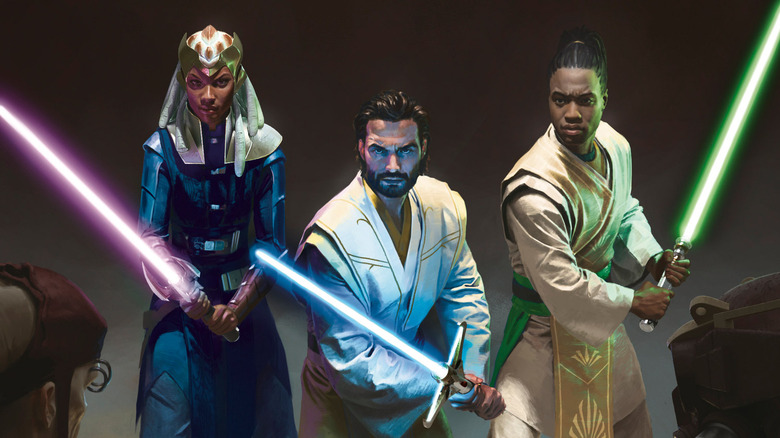
What was the first taste of "The High Republic" that you got in general, because I think it seems like it's a little bit out there, right? On the surface, it's like, "Okay, we're going to do something, it's going to be way in the past, and it's going to be new," so what was your first introduction to "The High Republic" as a concept, and then how did you wade deeper into it?
I think because of where I work, I heard things before I really saw anything about it. I knew about Project Luminous, which was the code name, but I didn't really know what Project Luminous was about. I knew the authors that were involved in breaking that story, and I had interviewed most of them for various other projects that they've worked on. I knew them and I knew their work, and so I knew I trusted whatever they were creating, but I think, if I'm remembering correctly, my first real understanding of what "The High Republic" really is and really set out to be didn't come until the launch event in February 2020 or maybe a little bit beforehand. I might have had an early-ish preview because of covering it for StarWars.com, but I think it was just right around that time that I really saw the first concepts art and really got a sense of what that story was.
Do you have a favorite highlight of "The High Republic" so far just as a fan? Because I know you're as big of a "Star Wars" fan as me or anybody.
It's so hard, because I just love so many of these stories and characters. I remember when I was reading "The Rising Storm" for the first time, and it was one of those rare books for me where I [was] literally laughing out loud and crying [and] legitimately tearful over things that are happening in the story. It's one of my all time favorite "Star Wars" books now, but it was just something that I was so glad could be part of. I love that book, but for me, also discovering on the comic side, the Marvel "Star Wars — The High Republic" comic run was really eye-opening in terms of allowing us to have a Trandoshan Jedi who is front and center and something we've never seen before. But also just following Keeve and her trials as she's trying to figure out what it means to be a Jedi. You're seeing so much of what's happening in the books through her eyes and you're meeting so many of the same characters in comic form, and it's just a really elegant way to pull all those stories together and allow you to have some more of that connective tissue between a character that you might see on a book cover or imagine for yourself based on the author's description in a novel, but you really get to spend some time in their presence in the comic run...
What "The High Republic" authors have done is allow everyone to see themselves within one of the Jedi, which is really amazing because, when you think about it ... there's a lot of species variety among the Jedi that we know from the prequel era, but they're all very buttoned up and following the order and of a very specific ilk, and we don't really delve into those individual personality traits as much as we get to in "The High Republic."
I'm curious what the process is like. The way the book is laid out, you have chapters that are written very much in a journalism style where you're explaining the background through interviews, but then you're also individually giving some of those snippets on the art itself as you go through. Do you get to start diving into the artwork first? Do you start with the interviews? How do you approach a project like this?
From the very beginning of when we knew we were going to do this project, I got access to all the concept art and art that was being created for it, so I really just got to swim through that, Scrooge McDuck-style in his money pit, but just going through all of those different pieces and looking at the embarrassment of riches that we had created for "The High Republic" and really starting to puzzle out, "Okay, what do we have here, and how could we possibly organize this?" Because in a lot of the-art-of series books that are based on a film or live-action series production, it really moves through the pre-production, production, post-production phases in terms of organization.
I realized very early on that we couldn't do that with this one, because you've had the summits bringing everyone together as one point on the timeline, but then you had all of these people scattering, all these new artists coming in all over the world and everybody is working at the same time, and it would've gotten really, I think, difficult from a narrative perspective to put all of that across on a chronological level for when it happened.
What we ended up doing was deciding to follow more of that character-based approach, but still give you that introductory chapter where you really get to understand more of the making of "The High Republic" and then delve into, "Who are the Jedi? Why was it important for the authors, artists, creators to make the Jedi as we find them at their peak in The High Republic? Who are The Nihil? Who are the villains? What's really the Republic about at this time, and who are some of the characters and places that we see there?"
I think it really just gave it a good structure and a structure that just, to me, made a lot of sense and would allow someone also who comes to this book and says, "You know what, I care most about the ships," to just flip to that chapter and dive directly into it if that's the thing that pulls your heart the most, rather than forcing you to move through it from start to finish in order to best understand it.
'There Was No Question About Keeping It In'
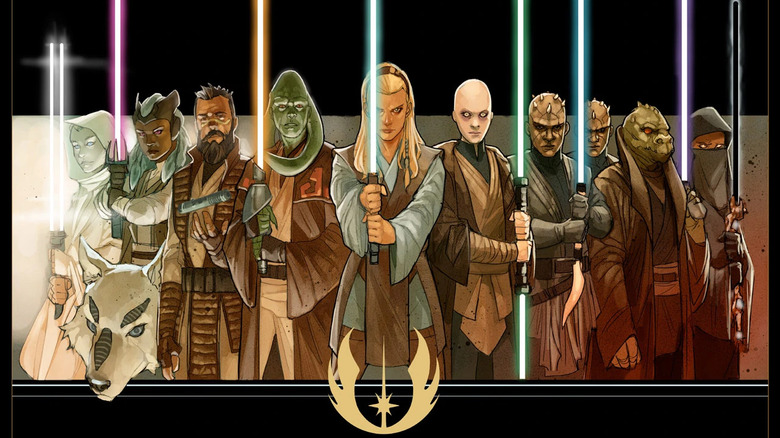
How did you organize doing the interviews? Interviews take a lot of research. I mean, you have a journalism background and you're a really fantastic interviewer. As someone who has to interview folks, I'm curious about what your process is for that.
I think my first order of business was to talk to Mike Siglain. He is the captain of "The High Republic" ship. He's the head of publishing for Lucasfilm and the creative director. He has been a passionate supporter of doing a project like this and then an advocate for this specific project from day one. I knew he was the best first interview, the best person to really kick it off and help me understand the scope of this, the importance, and really just talk through everything. I know I interviewed him more than one time. He might have been my last interview, too. He might have been a first and last out kind of a bookend interview just to make sure that we covered all the bases.
I talked to the authors in that first wave, too, I think pretty early on. I knew they were so integral to breaking those stories and setting out who the characters were, but then, of course, it's an art book, and so you want to hear from the artists directly and find out what their inspirations were for individual pieces. Before I did any of those interviews, one of the things I did was talk to Phil Szostak, who's written a number of the art-of books, because I knew he and I are coworkers and friends, so I had that luxury of just over lunch saying, "Phil, how do I do this?" but also I knew he definitely knew how to do this and had evolved his own process with it and would be able to give me some tips so, right out of the gate, we could have a really successful research period and interview period with all these amazing and talented creators.
One of the things he suggested I do was something that he's done before for the art-of books, which is catalog all of the art from one specific artist, pull it all together and then, if you can, sit down with that artist and show them the art. They've obviously seen it before they made it, but show them the art, sit down with them with their pieces and ask questions while you have that visual because it's a great thought starter and it's also just a really nice way then on the captioning side to make sure that I'm connecting the right Yoda piece with the right quote.
Was there anything you had to fight to keep in?
No. It was so supportive that I was ready to fight for some things, and then the fight never happened. The fight never came. I'll give you an example of that, because Cavan Scott had been extremely candid about his writing process with the Marvel comic, and he told me this great story about turning in issue one and then pandemic happened. Things were in a pause, and he had all this extra time and he wasn't happy with it, and he completely just eviscerated it and rewrote it from scratch. He told me all of the nuts and bolts of what he intended to do and how the characters didn't even resonate with him, and so he just felt like it was wrong.
It was this really just raw look at the creative process. When I wrote it into the book, I thought, "Ah, this is really important. I really want this to stay in. I hope that I'm able to keep it, but I will fight for this," and then there was no question about keeping it in. There was no pause. It was just a wonderfully supportive, collaborative environment where we really strived to show all of the warts-and-all approach of ... there were a lot of interesting conversations happening, too, among the authors, of which characters might not make it through phase one and why that was important or why it was important to kill off a character or why it was important to absolutely not touch that one character. All of those stories are in the book as well, so, yeah, just a completely free space, I think, for everyone to just tell their stories and then get them into the book.
'You Can See In His Line Drawings That He Loves This'
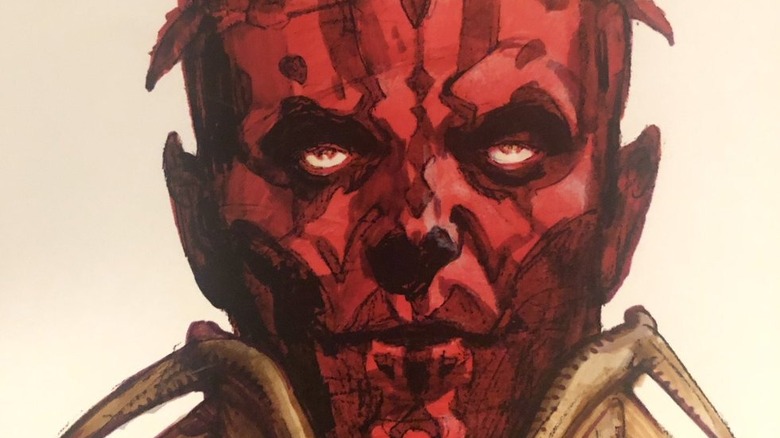
One of my favorite stories in the book that I think you documented really well was about the initial ask of Ian McCaig. I'm wondering if you can talk about that story specifically because Ian McCaig, for those who might not know, he was one of the artists and costume designers on "The Phantom Menace." His work is so iconic, and that first image of Darth Maul is his.
That particular story was based on three or four different interviews that we did for the book where you're getting that story from slightly different points of view and putting them all together. I think it's a really interesting piece of the story, too, because, to your point, Ian McCaig has been a really integral part of the "Star Wars" legacy. Not only did he design Darth Maul and Padme Amidala for "The Phantom Menace," which I think is where a lot of people know him from, but he was also working for Lucasfilm before that. He had some time spent working with the Special Editions. I think he appears as a stormtrooper in one of the pickup shots for "The Empire Strikes Back," if I'm not mistaken, and then you also have him continuing on with that where he's done art for other productions in "Star Wars" in more recent years. He's really just such an essential part of the "Star Wars" family.
Interviewing Ian himself and Mike Siglain and Troy Alders, they all told me the same story, but from their various points of view, where I think Troy was a little more optimistic that Ian would be in for it or at the very least that they could reach out and ask him. I think Mike was really ready before they even asked to just say, "No, we can't. We cannot ask the person who designed Darth Maul to come over and help design things for this publishing initiative. He's worked in all kinds of film productions. He's Ian McCaig. He's going to be too hard to get."
I'm so glad they called him, because it's very clear from both his immediate yes to them, but also then, from my own interviews with him, that his first love is books. To be able to contribute to the "Star Wars" galaxy in book form was such a joy for him, and you can see that in the pieces in the book, too. You can see in his line drawings that he loves this. He is just having the best time. He's also just such a nice person, which I don't think I was prepared for that part of getting to talk to Ian.
I think sometimes, when you respect someone's work so much and you only know them through that work and that work is so, to use a word that I don't like to use too often because it loses its meaning, but absolutely Ian McCaig's work all allow it, his work is iconic. When you see someone in that stratosphere, I remember preparing for my first interview with him and thinking like, "Oh, I probably only have one shot at this. I better get all my questions in," being a little nervous, and then he was just the nicest human being. We talked too much to the point where we both had to go because we had other things we had to work on. We didn't get through all of the amazing art that he did for the book, and so we had to schedule more time, which was really just a joy. I could talk to the man all day, and I would if I were allowed to.
'I Loved Interviewing Ario Anindito'
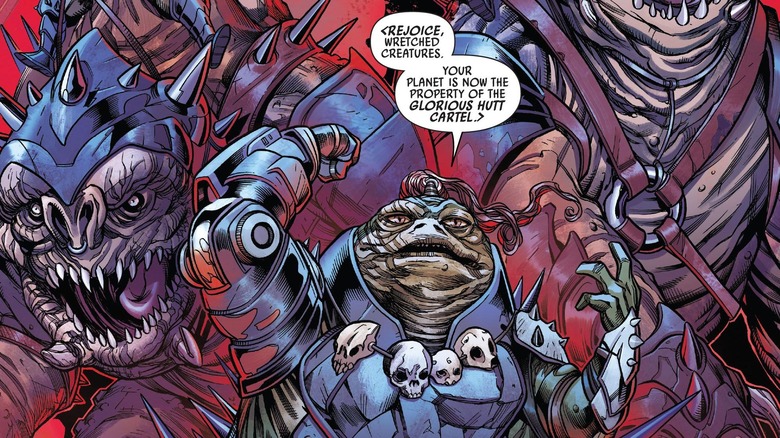
Was there a particular interview that was the most fun or the most funny?
I think probably two of my favorites were definitely Ian, both because he is so lovely, as I said before, but also he's so insightful. Part of the reason we needed multiple interviews was because we would go off on a tangent and we would be talking about mortality, and I would realize that he was telling me a great story, but it didn't necessarily factor in for the book or he's telling me a great story and then it ends up as one of the chapters and it's not tied to any particular piece of art. We would go off on all these amazing side roads and talk about things like that.
Then I loved interviewing Ario Anindito, just exuberant about being a part of "Star Wars." One of the quotes that made it into the book was he said he felt like Ario "Anakindito" because he felt like, when he got the gig, he was the chosen one. There's a whole backstory, too, where there was another point where he got asked to do some "Star Wars" and he declined because he didn't feel like he was proficient enough with ships and he didn't want to ruin "Star Wars" because he loves it so much, so he was like, "No. No, I can't do a subpar job on this," and he declined and then was kicking himself.
It's just such a gratifying story for him to get another chance at that and to come in and do such an amazing job with everything he touches in the Marvel run and just some really exquisite, beautiful pages, some gorgeous covers, but then also, again, just hilarious. We talked for hours and hours. I can't remember. It was like a three or four-hour interview. It went on for quite a while. Some of it was the time difference, so we had to schedule it for a pocket of time where we were both overlapping and we were both awake. We were just having such a great time and having so many inside jokes.
I think those two, because I had not interviewed Ario or Ian previously coming into this book, some of my fondest memories are those conversations that I had with the two of them and just feeling like I really just met this person even if I knew of them and their work, but just feeling immediately such a bond with the pair of them and just having such a good time.
It's funny you say that. I did an interview with Nilo Rodis-Jamero, who worked with Joe Johnston and Ralph McQuarrie on "Return of the Jedi," and he became the costume designer. He was an industrial design student, and he told George Lucas like, "I don't want to take this job because I don't know anything about movies or science fiction," and George was like, "No. That's perfect. That's what we want." It's interesting that now you've got generations of people who grew up on "Star Wars" and are like, "I don't want to screw this up." Back then, it was like, "I don't even know what you're talking about. Please don't hire me."
Yeah. Well, it's just that feeling like, oh, in order to work in film, I guess I must already [have] a background working in film, but it's like, no, what you need is to be able to put together a vehicle that makes sense and could potentially work and that someone will look at and go, "Yes, I could see how that could exist."
'One Of The Other Ones That Really Jumped Out Was 'Kamen Rider''
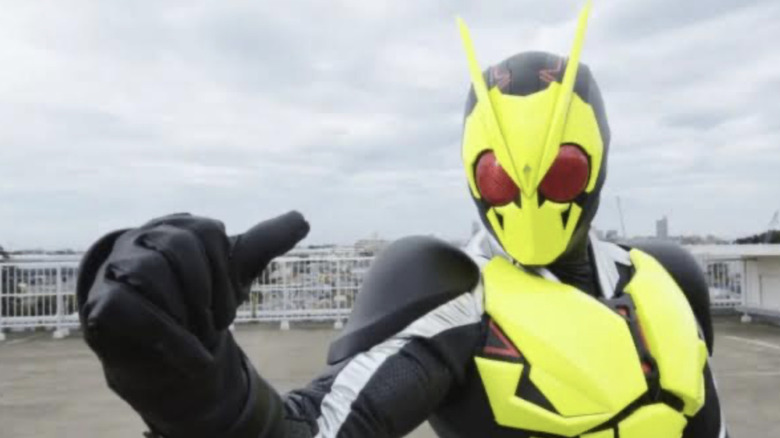
Is there anything that stood out in the research of the book as far as influences from other places?
I shouldn't have been surprised by "The Fly" because the piece it goes with is clearly a very Fly-like Jedi. Even flipping through the art before talking to Ian about it, I was a little surprised by that particular connotation and delighted, surprised and delighted. One of the other ones that really jumped out was "Kamen Rider," which was not something that I was familiar with from my own upbringing. It's a Japanese manga superhero. That character was a factor into Ario Anindito's design concepts for the Ridadi. You can really see that if you look up Kamen Rider and then look at the Ridadi's face. It's just really fascinating to hear all about something that was extremely important to him and something that he loved as a child and here's how it seeped its way into inspiration then for a totally different character, a new species in the Star Wars Galaxy.
What are you most looking forward to in "The High Republic" as it's coming up, because we've got phase two, wave one, I guess? We're in the swing of now and we've got "The Acolyte" shooting...
And we have "Young Jedi Adventures" coming to animation. It's already been in VR. There's plans for it to be in the gaming space and just everywhere. Everything is coming up Milhouse, but it's "High Republic," and it's great. I have to say I'm really, really excited for "The Acolyte." I'm really curious to see where that goes just based on that paragraph that we got so far with the cast announcement explaining what that story is. It sounds really amazing. Also, I am really excited for "Young Jedi Adventures." I've seen the character art that was released. It's both adorable, but I'm really cognizant that, for kids, sometimes it's hard to find that path into "Star Wars" because a lot of our characters are teenagers, so if you're a younger kid, it's harder to find another kid character that you relate to. You've got Anakin in "The Phantom Menace," and you've got a couple other characters now for sure that have come out in recent years including in "The High Republic," especially "High Republic Adventures" where the whole cast is Padawans. But really, it's just nice to see more kid characters coming in. That, hopefully, will allow child fans and adults to really find a character that they relate to and that they can follow for a bit.
"Star Wars: The Art of the High Republic" is available in bookstores everywhere.
Read this next: Star Wars Deleted Scenes That Could've Changed Everything
The post The Art of Star Wars: The High Republic Author Kristin Baver on Organization and Execution [Exclusive Interview] appeared first on /Film.
0 Commentaires